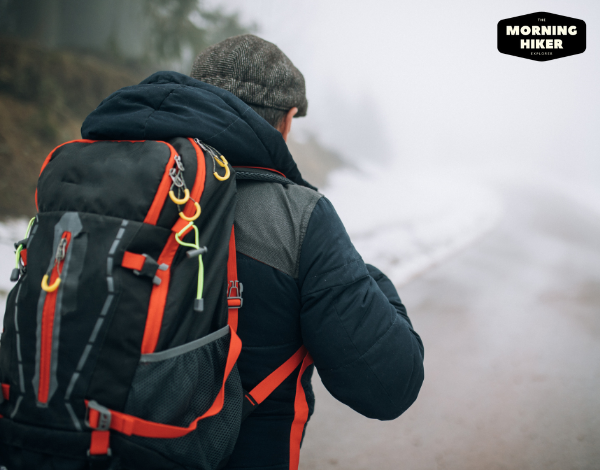We recommend hiking with a partner but hiking alone can be enjoyable but dangerous if you fail to follow a few basic rules.
This post contains some affiliate links to products that I use and love. If you click through and make a purchase, I’ll earn a commission, at no additional cost to you. Read my full disclosure here.
The internet is filled with horror stories of bad things that happened to people who went on a remote hike by themselves.
For example:
Aron Ralston was hiking (climbing) alone in Utah when a boulder dislodged, trapping him in a canyon for almost six days (127 hours). He escaped by cutting off his own arm with his pocket knife.
You can watch his horrific ordeal in the video below (contains actual footage from Aron):
Is hiking alone dangerous? It casn be! Does this mean you should never hike solo?I don’t think so. But there are a few rules you need to follow if you hit the trail by yourself. Follow these and you should have an enjoyable and safe hike.
In This Article
Tips For Hiking Solo
If you do plan on hitting a trail by yourself, keep these things in mind. Always think, ‘safety first.’
1. Know Your Experience Level
Are you equipped to survive if the worst-case scenario happens? I realize this is relative to the location you are hiking, but it’s an important question to ask yourself.
The key is to be prepared for the unthinkable. We all make mistakes while hiking. The question is, do you know what to do in an event of an emergency.
Do you know what to do if you encounter a bear or other wildlife?
Have you ever hiked alone before? I realize we all start somewhere, but if you are inexperienced, start small and short. Don’t try the Appalachian Trail by yourself if you’ve never hiked in your local area alone.
Do you know what to do in inclement weather? Are you prepared for rain, snow, ice, heat, etc?
Let’s face it, things change quickly in the mountains. I tell the story here about our first hike up the Barr Trail (The Incline) in Colorado. My point? We didn’t know the area and things changed unexpectedly. We were ill-prepared for the turn in the weather.
There were many people on the trail so we were never in any real danger. It would have been a different story if I was alone. Not life-threatening, but certainly hazardous.
2 Let someone know where you are.
I recently read a story about nine hikers who failed to check-in (it was required in this remote area). It took several days before anyone knew they were missing. They were eventually found, but if they had followed the rules they would have been found sooner.
By violating the basic rule of letting someone know where you are hiking, they put themselves at risk.
What You Should Let Them Know
- Location of your hike
- The time you hit the trail
- When you expect to return
- What you are wearing (key clothing colors, etc)
- Where you parked your vehicle
- Any other pertinent information you think could help if you get lost.
3. Carry The Right Tools and Gear
Having the right gear can mean the difference between life and death (literally). There are certain tools you should have in your backpack even on short hikes. I’ll cover a few of the basics below, but first I want to tell you about a close call I had one morning.
My Close Call
When we lived in Colorado, my wife and I decided to take an early morning hike near the Garden of Gods Park. We lived within walking distance of the park. It was early (around 6 am) when we hit one of the trails.
Our morning hikes were a time to connect. We came to a specific spot on the trail with a 10-foot rock ledge that ‘jutted’ up out of the ground. Knowing there were beautiful views along this trail, I wanted to see what was on the other side of this natural wall. I briskly left the trail and climbed up the ledge to see the view.
After a moment, I jumped down from the ledge. As soon as my feet hit the ground I heard a sound I was very familiar with – the rattle of a rattlesnake. Because I wasn’t paying attention to my surroundings, when I left the trail I walked right through the middle of a bed of rattlesnakes.
I froze. As calmly as I could, I told Michelle not to move. I wasn’t sure where they (yes, multiple) were and I didn’t want her to step into the middle of them. After getting my bearings, I scanned the ground to see five rattlesnakes within 6 feet of me. Several were coiled ready to strike.
I had walked right through the middle of them. When I finished my headcount, I told my wife to slowly walk down the trail. I wasn’t sure what I would do at that point, but I wanted her out of harm’s way.
After what seemed like an eternity, I made my decision. They weren’t leaving the area and seemed to be more agitated by the second. The only thing I could do was leap and run. I did. And made it to safety.
While this didn’t happen while hiking alone, it could have. I was in a dangerous situation. I tell you this because I made several mistakes. I didn’t pay attention to where I stepped. I was distracted. I made sudden movements. And a host of other little things that could have been disastrous.
One big mistake was not being prepared. I had a backpack but decided to only carry water and a jacket because we weren’t planning on a long hike. I was not prepared for an emergency. We had no ‘gameplan’ on what to do if an emergency happened.
Since then, I never hike unprepared. And I try to always have a plan for emergency situations. This is especially necessary when hiking alone.
Solo Hiking Essentials
I believe it is important to always have a backpack or bag with a few essential items; even if you are hiking well maintained and heavily traveled paths. On more than one occasion I’ve walked up on minor emergency situations with families who did not have an emergency kit.
I recommend these key items for your solo hike:
- An emergency kit
- Knife
- Compass
- Emergency Contact System
- Bear Spray
- Rain Jacket
- Plenty of Water
- Map
- Insect Repellant
- Firestarter
- Flashlight
- Food
- Headlamp
- Emergency blanket
I also like to hike with a trekking pole. Not only for balance or help with walking but as added protection against wildlife.
4. Only Hike Trails That Are Well Marked and Maintained
One of the big mistakes beginner hikers make is leaving marked trails or not paying attention to the trail markers. Trust me, it’s no fun getting lost in the woods.
I’ve never been ‘lost’ but I have missed markers that were not maintained well and found myself far from where I wanted to be. I’m not a novice hiker, so it was more frustrating than anything. For beginners, it can be unnerving and frightening. Especially if you are in an unfamiliar area.
I only recommended solo hikes on well maintained and marked trails.
You can usually find information on trails with the AllTrails App. If I hike somewhere I’ve never been, I make sure to read the reviews and recent information about the trail. You can usually find if the trails are marked well, and if not, what to look out for.
This is a must in any situation. It goes double when hiking alone.
Mistakes People Make While Hiking That Put Them In Danger
The biggest mistakes people make on a solo hike are mental. It’s vital to make sure your head-is-in-the-game when you are hiking alone. You have no one to rely on but yourself, so make sure you are mentally prepared.
Mistake #1: Failure To Plan
Don’t hit the trail alone without having a plan for your hike. This includes mapping out your course and letting someone know where you are. See the notes above.
It is not a good idea to ‘just go for it’ on a whim. You put yourself at risk to the degree you fail to plan.
Things You Need To Plan
- Where you will hike
- What to wear
- How long will your hike take (don’t get caught on the trail after dark)
- What is the terrain like
- Will you need food
- How much water will you have
- What will the weather be like?
Mistake #2: Going Off Trail
No one likes ‘off trail’ more than me. But I never go off the marked trails alone.
When my son-in-law came for a visit in Colorado I seized the opportunity to explore a remote area I’d been wanting to hike. I knew it was not wise to go it alone, so when he came for a week, we took a day to explore. It was one of my favorite times in the mountain. I couldn’t (wouldn’t)have done it without him as a partner.
In this video you will see the gripping story of Amber Kohnhorst who was lost in Cane Beds, Arizona.
This is a mistake many hikers make. They venture off-trail (and abandon their plan) run into problems. If you want to explore, always have a partner. Stick to the marked trails if you are alone (or you are an experienced hiker).
Mistake #3: Not Paying Attention To Trail Markers
This can be as bad as going off-trail. If you miss a trail marker because you were distracted, you ca wind up miles from where you intend.
One way to stay prepared is to have a trail map. A physical trail map is good to have in case you lose cell service. A good map will let you know key markers (not just the ones posted on trees) so you can make sure you are following the correct path.
Check with the local national parks office for trail maps and information about closures and other issues you might want to know about.
Mistake #4: Not Having an Emergency Kit
My story above about my encounter with rattlesnakes is a classic example of being ill-prepared. If I had gotten bit by a rattlesnake I would have been in serious trouble. Snake bites can be treated if you have the right help when it happens. I did not. It was a mistake; one that I’ve never let happen again.
I now carry a first-aid kit on all hikes – small and large. Here are two cheap recommendations.
It’s not only important to have an emergency kit, you need to know how to use it…
Mistake #5: Not Knowing What To Do in an Emergency
Having an emergency is not enough. You need to know what to do in an emergency.
Every hiker should be skilled in emergency techniques. Atomic Bear offers an inexpensive online course to help you get prepared for unexpecting events. This is a combat level medic course.
First Aid Training by a Combat Medic – A Complete Course
We encourage our readers to never make a hiking trip without an emergency kit. Use the code ‘Morning Hiker‘ for a 20% off coupon at Atomic Bear.
Mistake #6: Overestimating Your Abilities
We talked about this earlier (Know Your Experience Level). This is something many beginning hikers fail to take into account.
Before we moved to Colorado, we attended a conference in Colorado Springs. On the second day of our stay, we decided to skip a few sessions and go for a hike. We ended up doing a 9-hour hike at about 7,000 ft. Needless to say, we were not prepared for how the altitude would affect us.
Even though we are both good hikers, we under-estimated our abilities at that altitude. We got headaches, body aches, and were quite light-headed for the afternoon.
Point? Even if you are pretty experienced, it can be a common mistake to overestimate your abilities.
Mistake #7: Not Calculating Weather Conditions
There are many factors to consider along with weather conditions.
Forecast: Novice hikers often to forget the check weather conditions where they will be hiking. This can turn a fun hike into a miserable experience if you miscalculate weather conditions.
Elevation: A good rule of thumb is for every 1000 feet in elevation the temperature will drop 5 degrees. This is always the case but it is a good rule of thumb to go by. Plan accordingly.
Is hiking alone dangerous? Not if you practice common sense, stick to the rules, and avoid these costly mistakes.
Relate Questions Readers Ask
Other questions you might consider when hiking alone:
Is it safe to hike alone as a woman?
Is it safe to hike alone as a woman? In short: Yes, it is perfectly safe. It’s also a fantastic way to enjoy nature and relieve stress. Most women who hike alone do so fearlessly and regularly and are not looking to be rescued.
The idea that it is dangerous for women to hike alone is a myth that needs to be debunked. This stereotype comes from the fact that women are generally smaller and have less powerful muscles than men, but it doesn’t mean they can’t or shouldn’t hike.
Hiking alone is not recommended for women that are new to hiking, women that are out of shape, or women that are not comfortable with their surroundings. However, if you are an experienced hiker that is in shape, hiking alone is not unsafe (as long as you follow the rules mentioned above).
Just use your common sense and follow those safety tips.
Can a beginner hike the Appalachian Trail?
The Appalachian Trail is a wonderful hiking trail that stretches from Georgia to Maine and is approximately 2,189 miles long. It winds through some of the most scenic areas in the country, as it crosses through 14 states.
The Appalachian Trail has become a popular adventure for beginning hikers even though it is the longest hiking-only trail in the world. While many of those who take on the AT are experienced hikers, many are not.
The Appalachian Trail is a long and demanding trail, no matter how well you’ve prepared for it. Because of the attention, the Appalachian Trail craze has gotten recently, more and more beginners are trying their hand at hiking it. It can be daunting. But it can also be a lot of fun.
If you do plan to hike the AT, I recommend going with a partner. Especially if you are a beginner.
Why You Might Want To Hike Alone
We’ve discussed the dangers and tips for solo hikes, but are there benefits for hiking alone? Yes.
It can be very therapeutic to solo hike. Here are a few benefits of hiking by yourself.
For starters, hiking alone gives you the opportunity to explore and discover new things about the environment around you and go at your own pace. It also affords you a chance to learn about yourself and notice things that may like attention in your life that you usually miss when it’s just you and your partner.
One of the wonderful things about hiking alone is that you do not have to worry about another person’s pace and can go at your own. Hiking alone also provides you with the opportunity to reflect on all those nagging issues in your life that you usually find harder to do when surrounded by other people.
Something else I like about hiking alone is that it affords me some peace and quiet. Sometimes I just want to be alone because that’s when I can release all that negativity in my mind and not have to worry about other people.
You also get to decide when you want to stop to enjoy the scenery or take a quick rest break. You do not have to wait around for the others in your party if you want to take a few pictures or just sit down and relax for a bit.
Here are a few benefits for getting alone in nature
- Getting to know yourself
- Spiritual connection
- Appreciation of nature and the outdoors
- Developing life skills
- Self-dependence
- Personal growth
Final Thoughts on Hiking Alone
Hiking alone can be dangerous if you are a novice or trekking in an area you are unfamiliar with. We listed four (4) tips if you are hiking solo, as well as seven (7) mistakes people make when hiking alone.
If you follow these basic, common-sense rules of hiking you will be safe and have a great experience.



We are participants in the Amazon Services LLC Associates Program, an affiliate advertising program designed to provide a means for sites to earn advertising fees by advertising and linking to Amazon.com